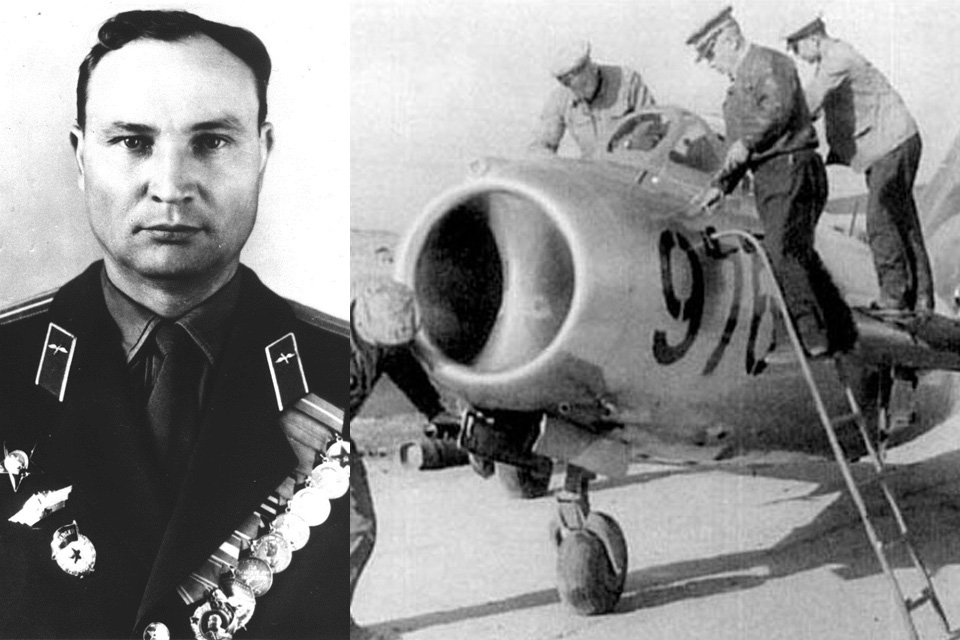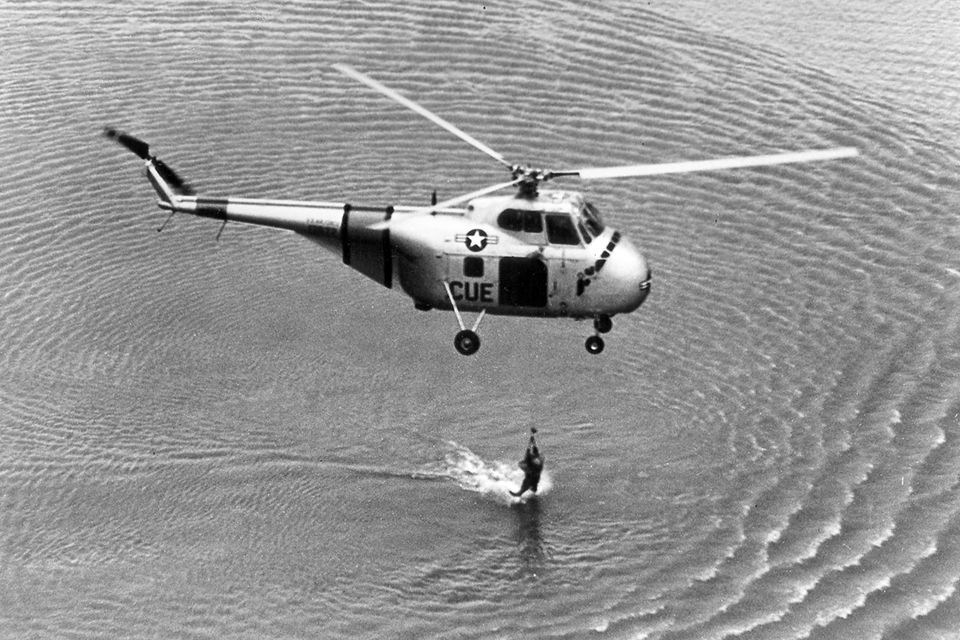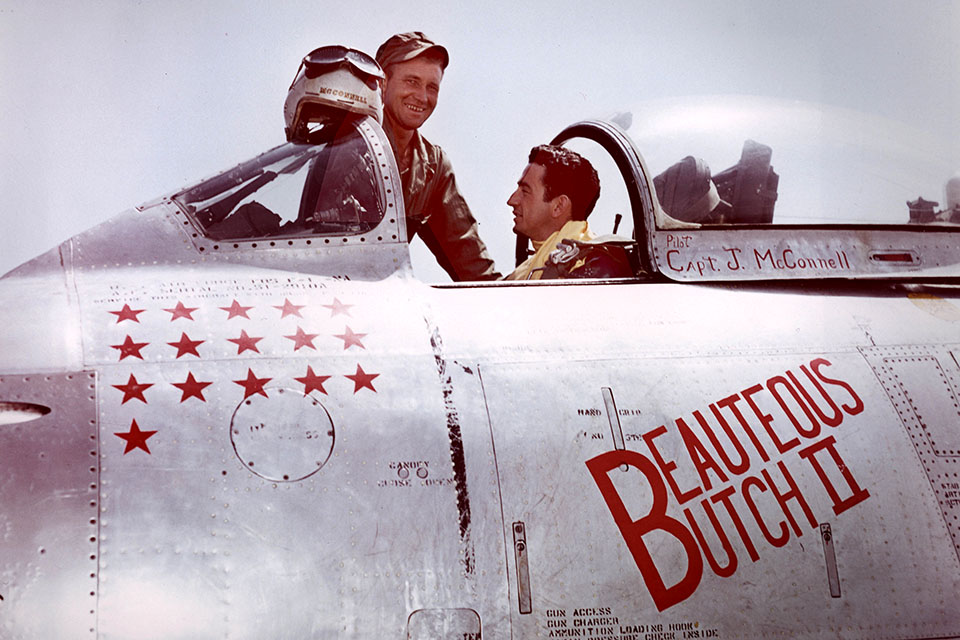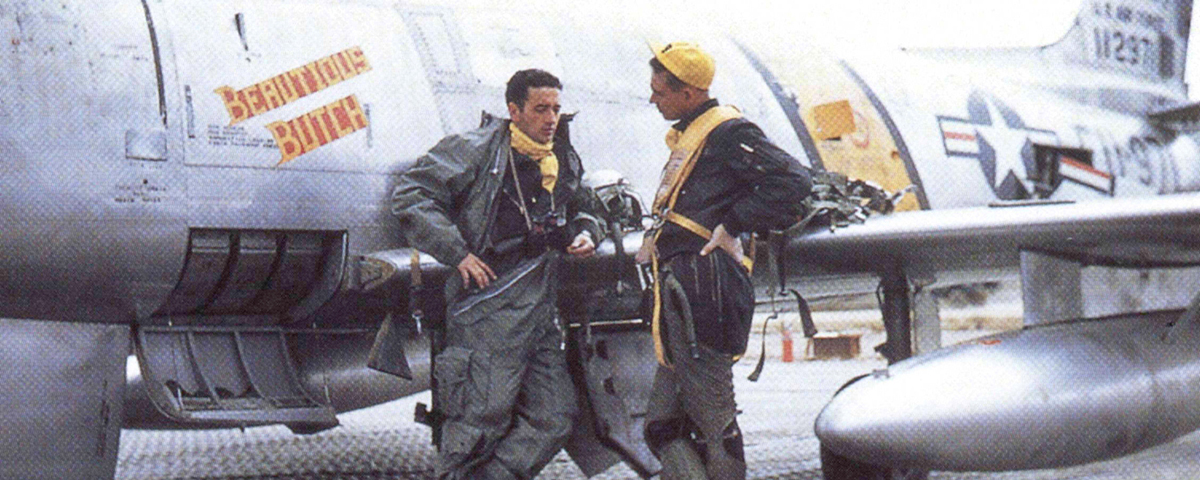In recent years, Russia has confirmed a fact long suspected by United Nations airmen: Soviet fighter pilots flew and fought during the Korean War. Since that revelation, numerous Russian pilots have emerged from the shadows of secrecy to meet and compare notes with their former American adversaries. In the process, cases have turned up in which outstanding pilots from both sides met in classic duels of “ace versus ace.” Two such champions, Mikoyan-Gurevich MiG-15 ace Semyon A. Fedorets and Joseph M. McConnell, who became the American ace of aces of the Korean War flying the North American F-86 Sabre, battled each other in the spring of 1953.
Born in the Ukraine in 1924, Semyon Alekseievich Fedorets flew his first combat missions, ironically enough, in American-built Bell P-39s during World War II. He mainly flew in defense of Leningrad during 1944 and 1945, and since this sector was quiet throughout that period, he had no opportunity to score against the Germans. When the Soviet Union decided to commit aircraft to support the failing North Korean effort during the Korean War, however, Fedorets happened to be serving in one of the fighter air regiments (Istrebitelski Aviatsiy Polki, or IAPs) in the Soviet far east, the 913th IAP of the 32nd IAD (Fighter Division). Prior to his Korean deployment, Fedorets had become a flight commander, and his aerial and ground gunnery record was the best in the 54th Air Army. The 913th IAP was deployed to China in April 1952, and 28-year-old Fedorets flew his first combat sortie in September. On December 17, he reported his first victory, over an F-86:
Our regiment scrambled and we received our tasks in the air. Our squadron flew in two four-plane flights….Me and my wingman Sasha Popov were the last ones in the formation. We engaged the Sabres at an altitude of 13,000 to 14,000 meters. We had the height advantage and they soon broke from the fight and headed for their base. The regiment commander, Major [S.I.] Babich, ordered “Cease the chase,” and we headed for home too. Me and Popov were left behind and we headed for home. Soon Popov reported “Look! A Sabre is coming behind me!” I looked and saw him behind my wingman’s plane and a little bit lower. I ordered: “Go straight and gain some altitude!” I did a hard left turn and attacked the F-86. It was late, however, and he managed to fire a burst at my wingman. Sasha cried on the radio, “He is shooting at me! My airbrakes are gone!” I closed in and fired from 500 to 600 meters. The Sabre did a hard left turn and headed for the Korean Gulf; I chased him, but soon it was apparent that the distance between us was increasing. When the distance between us was 1,000 to 1,200 meters, then I fired a one-second burst. The shells passed near the F-86 and he made a left turn and slowed down—just what I needed. I closed the gap and when I was at 600 meters I opened fire. I hit the Sabre in the cockpit; it dove and crashed 15 to 20 kilometers from the sea.

Fedorets’ account indicates no doubt on his part that he had managed to destroy his F-86 opponent; however, U.S. Air Force records list no Sabre losses for that day. During a sweep on February 19, 1953, Fedorets was flying in MiG-15bis No. 93 as wingman to Yevgeni Aseyev’s wingman when he saw a Sabre formation below them. The Soviets dived on the Americans, but one got on the tail of a MiG flown by Valentin Shorin, and Aseyev rushed to his assistance. Fedorets recalled:
Suddenly Aseyev told me: “25 (that was my call sign) get closer, I ran out of ammo,” and disengaged to my right. I immediately dove, ended up behind the Sabre, shot a burst at him at 300 to 400 meters, and I hit it. The pilot of the Sabre, seeing himself in danger, reversed and dove. I exactly repeated his maneuver, and upside down at 80 to 100 meters, I put it in my gunsight and gave him a short burst. I saw perfectly how a huge orange ball of fire emerged from the fuselage behind the cockpit, caused by the burst of the N-37 cannon. The sun reflected in the expelled canopy. The Sabre’s fuselage tore apart and fell to the ground.
This time Fedorets’ victim could be documented, for 2nd Lt. Edward Izbicky of the 336th Fighter Interceptor Squadron (FIS), 4th Fighter Interceptor Wing (FIW), ejected and parachuted down to become a POW. Two days later, on February 21, the 913th performed another fighter sweep, and Fedorets again saw action:
That day our mission was to intercept a group of F-80 Shooting Stars in the Hamkhyn area (over the Yellow Sea shore). We were flying at 14,000 meters altitude, at our maximum range. The enemy radars and the ones on the American carriers operating in the Yellow Sea saw us, and they ordered the F-80s to withdraw out of the combat area. Our [command post] realized that, and we were ordered to come back. We turned to the right and the squadron was closing on the city of Ansiu. In that very moment I noticed a group of Sabres, which were coming from the Korean Gulf, ahead of us, at an angle of 35 to 40 degrees and a little bit higher, at 20 to 25 kilometers’ distance. I told that to the squadron leader, Major S.I. Babich. He answered that he understood, but he had not received the order to attack. We closed on the enemy and our second pair went forward to the right, leaving the leader, Major Babich, as the last one on the left. The leading F-86 came closer, and Babich began to turn to the right at an angle of 30 to 40 degrees, which made his situation worse, because he left his tail exposed to the Sabres’ attack from 6 o’clock. They immediately exploited the advantage.
I was on the right and above. I saw that the situation was beginning to disfavor us, and I performed an energetic climbing maneuver to the right, then I turned to the left and I rapidly attacked the Sabre leader. He had enough time to shoot at Babich and damage him. I got closer to the Sabre and I fired a burst at him with the cannons at 300 meters, and another one at 100 meters. The Sabre turned to the right and went down, releasing black smoke. Babich’s plane was emitting white smoke, but kept on flying while descending. Babich came to the rest area of Ulumbey, and then he bailed out, landing safe and sound.
Babich was credited to Captain Vincent E. Stacy of the 4th FIW’s 335th FIS, who had previously shot down a MiG on January 17. Fedorets then downed Stacy’s F-86F, but he ejected over the sea and was picked up by helicopter. Babich appointed Fedorets as the new squadron leader, and in that role Fedorets claimed another F-86 on March 3, though again U.S. Air Force sources show no corresponding loss.
About a month after Fedorets scored his first aerial victory, 1st Lt. Joseph McConnell opened his own account by blasting a MiG-15 of the 224th IAP out of the sky on January 14, 1953. Like Fedorets, McConnell was a World War II veteran, but he had served as navigator in a Consolidated B-24 bomber. Although he later became a pilot, at age 28 McConnell was initially considered too old to fly the F-86, but like Fedorets he displayed abilities that swiftly gained him command of “D” Flight of the 39th FIS of the 51st FIW. In the two weeks following his first victory, “Mac” downed more MiGs on January 21, 30 and 31, and he scored his fifth kill on February 16. The “old rookie” had become an ace in one month and two days.
As with Fedorets, one of McConnell’s most impressive talents was his expertise at aerial gunnery. He was one of the few pilots who could hit his target from 1,500 feet away, the maximum effective range of the F-86’s six .50-caliber machine guns.
Most Sabre pilots preferred to get as close to the target as possible, but not McConnell. Time after time his wingmen watched Mac fire at the maximum distance and then saw a MiG either go down in flames or its pilot bail out. Nobody was surprised when, following combats on March 8 and 14, two more red stars were applied to Mac’s F-86E, Bureau No. 51-2753 (named Beauteous Butch after his wife). At that point, McConnell was promoted to captain.
April 12 was packed with aerial activity. Semyon Fedorets’ role in it began at 7:30 a.m., when he learned of an attack against Suiho dam by Republic F-84 Thunderjets, escorted by Sabres of the 51st FIW. All the MiGs of the 224th, 535th and 913th regiments scrambled up to engage the raiders, and Fedorets’ squadron was assigned to recover the others when the time came to withdraw. Again flying MiG-15bis No. 93, he spent most of the time observing the air battle from above.
“Suddenly,” Fedorets recalled, “I heard on the radio the anguished voice of one of our pilots crying for help. ‘Help me! I got hit!’ I looked down and I saw on the right at 90 degrees and 1,500 to 2,000 meters below a MiG-15 leaving a black smoke trail going northward, pursued by a Sabre that fired at him all the time. I didn’t think twice and I sharply broke right and descended, getting closer to the Sabre. I gave it two bursts at 100 to 300 meters. After the second one, the Sabre lost control, turned to the right and dove to the ground.”
Fedorets’ victim was 2nd Lt. Norman E. Green, a young pilot of the 335th FIS who had in fact managed to reach the East China Sea before ejecting and was subsequently rescued. While Fedorets was shooting down Green, however, a flight of four F-86Fs of the 39th FIS was closing in from behind. Leading it was Captain Joe McConnell. Fedorets recalled:
My No. 3 and No. 4, Aleksandrov and Shorin, lost track of me during my sharp maneuvers, but my wingman V. Yeframov stayed with me. When I was closing on the Sabre, I heard Yefremov saying, “A flight of Sabres behind!” He radioed such info and he went away to the left, leaving me alone without cover. As soon as I stopped looking through the gunsight and turned my head, a short burst struck my cockpit from the right and above.
I sharply broke to the right underneath the Sabre, getting out of his line of fire. The Sabre overshot and ended up in front of me at my right. The American pilot turned his head, he saw me and engaged flaps, with the intent to slow down, to let me pass forward and to riddle me at short range. I realized his maneuver and sharply broke left, while firing a burst at the Sabre without aiming. The burst struck the base of the right wing, close to the fuselage. A huge hole, about one square meter, appeared in the Sabre’s wing. It broke to the right and fell downward. That was my second enemy aircraft destroyed in that combat.
As soon as I got my plane out of the attack I was hit from below by a machine gun burst. I sharply pushed the stick and tried to disengage. The cockpit filled with smoke and kerosene, the instrument panel was destroyed and finally the new couple of Sabres broke any control. Using the trimmer, I leveled the plane and decided to bail out. With a tremendous effort, I was able to release the canopy and I successfully bailed out of my damaged plane at 11,000 meters’ altitude.
Unknown to Fedorets, the “new couple of Sabres” was in fact McConnell’s crippled F-86F. Immediately after being hit, Mac performed a barrel roll that put him in the 6 o’clock position behind his attacker, and exacted revenge.
“I happened to be flying the number 3 position in Captain McConnell’s flight the day he was shot down,” recalled 1st Lt. Harold Chitwood. “Mac was firing at a MiG after my element had taken a bounce. I then heard his wingman tell him to break; there was a MiG at 6 o’clock. Mac checked his tail but didn’t see the MiG as it was low at his 6 o’clock. When the MiG closed—he fired, hitting Mac—Mac immediately broke and the MiG slid past; Mac reversed and fired at the MiG, shooting it down.”
At that point, McConnell turned his dying plane toward the East China Sea while Chitwood quickly put in a call for a rescue team. “When Mac’s wingman said Mac was hit I broke off my attack, turned and immediately saw Mac’s smoke,” Chitwood said. “He had 50 to 70 percent power remaining, no radio, but control of his aircraft, and headed south to the water. A flight of MiGs followed us south but did not attack. Although Mac’s plane was emitting heavy smoke, there was no visible fire.
“I called air-sea rescue from Chodo for help,” Chitwood continued. “We spotted a chopper heading north which turned around and followed up until Mac bailed out. He was in the water only one to two minutes and back to K-13 before the day was over.”
According to his squadron mates, when asked about his experience back at Suwon Air Base, also known as K-13, McConnell responded, “I barely got my feet wet”—testimony to the expertise of Donald Crabb and Robert Sullivan, the Sikorsky H-21 helicopter crew from the 581st Air Rescue Squadron who had picked him up.

A Hollywood director could not have written a better script than the scenario enacted on April 12, 1953. The jet dogfight ended in a draw, with two Soviet and two Chinese MiG-15s destroyed for the loss of four Americans. In addition to Fedorets downing Green and McConnell, Grigory Berelidze of the 224th IAP shot down the F-86E of Robert Niemann, and later that afternoon Captain Seyonov of the 913th IAP downed an F-84E, killing James Wills. Moments after becoming an ace and raising his score to six, Fedorets had become the eighth victory for one of his victims.
Just four days later, McConnell was up again in F-86F Bureau No. 51-2910, Beauteous Butch II, and added another MiG to his tally. Yet another MiG on April 24 brought him double ace status. He scored again on May 13, 15 and 16, many of his victories chalked up on the “wrong side” of the Yalu River. In spite of orders not to engage enemy planes on the Manchurian side of the river, Mac did not hesitate to go after them there.
McConnell’s final fights occurred May 18, starting with a sortie in which he and 2nd Lt. Dean Abbott arrived at “MiG Alley” and saw two MiG-15s returning northward. McConnell gave chase, and the MiG drivers, aware of the Americans’ presence, requested assistance. Hoping to slow them down, McConnell opened fire at maximum range and, as usual, was able to score damaging hits on one of the MiGs. Abbott recalled:
At that very moment the help the MiGs had called for started showing up! I called a flight of four coming in from 3 o’clock, and another at 9 o’clock also. They flew right under us and we broke hard right into them, as they were much better targets than the two we had originally chased. In the break, I got out in front and one of the MiGs behind us started firing at me. Mac rolled in behind him and quickly shot him off my tail, and the pilot ejected. We broke hard right again, and again with me out front, the same thing happened again. Mac did a half roll, got behind him and shot him off my tail.
Somewhere in this melee, as I was calling out MiGs, I said, “My God, there must be 30 of them!” Mac responded, “Yeah, and we’ve got them all to ourselves.” We were the only two still in action that morning and everyone was listening, including the Battle Staff back in Combat Operations at Suwon. This audacious statement, plus the fact that he had just become a triple ace, gained Mac a lot of notoriety! From this point on, all we could do was break left and right defensively, trying to work our way back south as best we could. Probably the only reason we weren’t shot down was that there were so many of them that they got in each other’s way. We finally made it south of the Yalu and, thankfully they did not follow. Had they done so, we would have been out of fuel quickly, and they could have claimed both of us without firing another round. We limped back and landed on fumes. But we did make it.
McConnell’s victims were both from the 518th IAP of the 216th IAD—Captain Stadnik, who ejected safely, and 1st Lt. Rybakov, who was killed. Later that same afternoon, McConnell bagged a third MiG. Now credited with 16 victories, he was the leading American ace of the war, but he did not get a chance to add any more to his score. Lieutenant General Glen O. Barcus, commander of the Far East Air Force, did not want to risk this propaganda jewel. Many witnesses swore that Barcus’ pronouncement on his star performer’s future was “I want that man on his way back home to the U.S.A. before you hear the period at the end of this sentence.” In spite of that order, McConnell had enough time before he shipped out to recommend Abbott for the Distinguished Flying Cross, which he later received, along with promotion to first lieutenant.

Ironically, one of McConnell’s outstanding talents—his expertise in controlling the F-86 in simulated hydraulic failures—probably cost him his life. On August 24, 1954, while flying the newest F-86H from Edwards Air Force Base as a North American test pilot, McConnell suffered total hydraulic failure. He should have ejected at that moment, but Mac tried to land on a dry lake using only throttle and rudder. He had almost made it when unexpected air turbulence caught him. He tried to eject, but he was too low. It was a sad end for one of the best American airmen to fly in Korea.
The fate of McConnell’s opponent in the April 12, 1953, battle was considerably different. Flying MiG-15bis No. 16, Fedorets downed an F-86F on June 10, 1953, returning to Dapu air base with debris from the Sabre embedded in his plane. The pilot, Robert Cory of the 12th Fighter Bomber Squadron, was taken prisoner.
It was on July 19, 1953, that Fedorets claimed his final victory in Korea:
That day we were scrambled to intercept a formation of F-86s attacking Supun airfield. The enemy formation was not big—about 12 planes. Our GCI [Ground Control Intercept] operator missed the enemy planes and we scrambled too late. We were six planes and we headed for the enemy at treetop level. The visibility was poor. When we approached the airfield, a flight of Sabres from the top cover dove on us. I made a left turn and the fight was on.
An enemy plane opened fire on 1st Lt. Guerasimchuk’s MiG; he pulled up instead of making a hard turn. While climbing, another burst found his plane and set it on fire; Guerasimchuk ejected. Meanwhile, 1st Lt. Aseyev attacked a Sabre that was trying to shoot down his wingman, but he [the Sabre] ran out of ammo. The Sabre broke off the attack and headed for its home base. I saw that, intercepted it almost head-on and opened fire. The Sabre dove into the ground and exploded. Unfortunately, Guerasimchuk’s parachute didn’t open properly and he died on his 20th combat sortie.
Once again, U.S. Air Force records include no Sabre loss to match Fedorets’ claim. When the Korean War ended, he had flown 98 missions. His eight credited victories earned him the Order of Lenin, the Soviet Union’s second-highest military decoration. After retiring from active service with the rank of colonel, Fedorets continued to pass on his experience to future generations of Russian pilots as an instructor.
Diego Fernando Zampini writes for the Argentine magazine Aeroespacio and the Spanish publication Defensa. For further reading, he recommends: MiG Alley: Sabres vs. MiGs Over Korea, by Warren E. Thompson and David R. McLaren; and Korean War Aces, by Robert F. Dorr, Jon Lake and Warren Thompson.






